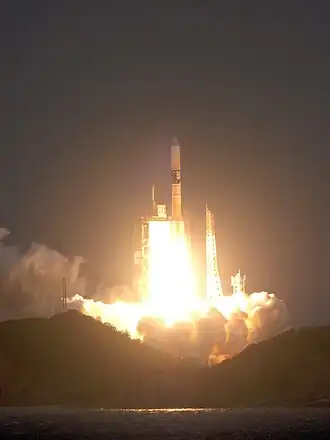WINDS
 Launch of WINDS (Kizuna) on H-IIA Flight 14. | |
| Mission type | Communication |
|---|---|
| Operator | JAXA/NICT |
| COSPAR ID | 2008-007A |
| SATCAT no. | 32500 |
| Website | JAXA |
| Mission duration | 5 years (design) Final: 11 years, 4 days |
| Spacecraft properties | |
| Bus | NX-G[1] |
| Manufacturer | NEC |
| Launch mass | 4,850 kilograms (10,690 lb) |
| BOL mass | 2,750 kilograms (6,060 lb) |
| Start of mission | |
| Launch date | 23 February 2008, 08:55 UTC |
| Rocket | H-IIA |
| Launch site | Tanegashima Y1 |
| Contractor | Mitsubishi |
| End of mission | |
| Disposal | Decommissioned |
| Deactivated | 27 February 2019, 06:54 UTC |
| Orbital parameters | |
| Reference system | Geocentric |
| Regime | Geostationary |
| Longitude | 143° East |
| Semi-major axis | 42,164 kilometres (26,199 mi) |
| Perigee altitude | 35,784.1 kilometres (22,235.2 mi) |
| Apogee altitude | 35,803.8 kilometres (22,247.4 mi) |
| Inclination | 0.2 ° |
| Period | 1,436.1 minutes |
| Epoch | 00:00:00 UTC 2016-08-31[2] |
WINDS (Wideband InterNetworking engineering test and Demonstration Satellite, also known as Kizuna), was a Japanese communication satellite. Launch was originally scheduled for 2007.
Launch
The launch date was eventually set for 15 February 2008, but a problem detected in a second stage maneuvering thruster delayed it to 23 February. Lift-off occurred at 08:55 GMT on 23 February from Tanegashima Space Center, and the satellite separated from its H-IIA carrier rocket into a Geosynchronous transfer orbit at 09:23.
Purpose
WINDS was used to relay the internet to Japanese homes and businesses through Ka-Band signals. It also tested technologies that would be utilised by future Japanese communication satellites. A part of Japan's i-Space program, WINDS was operated by JAXA and NICT.
Prior to launch, a JAXA brochure claimed that WINDS will be able to provide 155 Mbit/s download speeds to home users with 45-centimetre diameter satellite dishes, while providing industrial users via 5-metre diameter dishes with 1.2 Gbit/s speeds.[3]
Specs
WINDS had a launch mass of 4,850 kg, reducing to a mass of around 2,750 kg after thrusting to its operational orbit. The spacecraft is 8 m x 3 m x 2 m in size, and its solar panels have a span of 21.5 metres. It has three-axis stabilisation, and a design life expectancy of five years.
Decommission
The satellite became inoperable due to communications failure on 9 February 2019,[4] and it was decommissioned by the transmission of a deactivation command at 06:54 GMT on 27 February 2019.[5]
See also
References
- ^ Kallender-Umezu, Paul (24 November 2014). "Japan's NEC Looks To Expand Commercial Market Footprint". Retrieved 31 August 2016.
- ^ "WINDS (KIZUNA)". N2YO.com. 31 August 2016. Archived from the original on 31 August 2016. Retrieved 31 August 2016.
- ^ "JAXA - 超高速インターネット衛星―WINDS" (PDF). JAXA. 26 December 2007. Archived from the original (PDF) on 28 February 2008. Retrieved 23 February 2008.
- ^ 「きずな」(WINDS)の運用状況について (in Japanese). JAXA. 13 February 2019. Retrieved 6 March 2019.
- ^ 超高速インターネット衛星「きずな」(WINDS)の運用終了について (in Japanese). JAXA. 1 March 2019. Retrieved 6 March 2019.
External links
- JAXA website about WINDS
- LIVE COVERAGE: H-IIA KIZUNA (WINDS) Launch (updated 1:20 GMT) 1:20 GMT (8:20 pm EST): T-6 hours. Fueling of the H-IIA has commenced